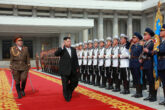February 12, 2018
Frustrations at the White House and the Pentagon
In early February, months-long tensions between the White House and the Pentagon over how to address North Korea spilled out into the public scene. As officials revealed to the New York Times, National Security Adviser H. R. McMaster had demanded that the Pentagon provide a menu of detailed military plans, including a “bloody nose” strike against North Korean nuclear facilities, in order to bring credibility to President Donald Trump’s threats. But the Pentagon, these officials noted, appeared reluctant to deliver on the request, seemingly worried that the White House lacked an appreciation of how quickly a military strike could escalate.
The reality is more nuanced. The Pentagon’s apparent refusal to deliver the White House’s desired military plans most likely derived from a number of factors unrelated to the Department of Defense’s feelings about the president or his foreign policy. In this case, the parameters likely set by the White House—low risk to U.S. forces, low risk to South Korea, low risk in provoking a North Korean response, but high damage to Pyongyang’s nuclear program or broader conventional force—may have simply been untenable. There is, after all, no effective surgical strike option for North Korea, no “bloody nose” that could reliably inflict determinative damage on military facilities without prompting devastating retaliation. The Pentagon always works more slowly than desired in the development of military plans, but ultimately cannot deliver on an impossible request—and is likely disinclined to offer less robust options.
Read the full article in Foreign Affairs.
More from CNAS
-
Trump’s Audacious Success
This article was originally published in The Atlantic. Nicolás Maduro and his wife awoke yesterday in a safe house on a heavily fortified military base in the center of Caraca...
By Richard Fontaine
-
North Korea and Russia’s Deepening Axis
2025 was the year North Korea turned a corner, not just through provocations, but by actively repositioning itself in the global power game. Its military partnership with Russ...
By Dr. Go Myong-Hyun
-
CNAS Insights | Eight Things to Watch for in 2026
Buckle up for a pivotal geopolitical year. In 2026, the world will struggle to make sense of U.S. actions and intentions, and Washington will remain uncertain about its own pl...
By Richard Fontaine
-
North Korea in Motion: New Moves, Sharper Risks, and Shifting Regional Responses
As 2025 winds down, tensions on the Korean Peninsula are escalating once again.North Korea is sending thousands of workers to Russian drone factories, stepping up cyber theft ...
By Dr. Go Myong-Hyun




